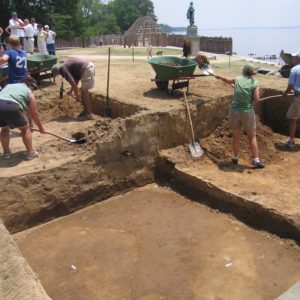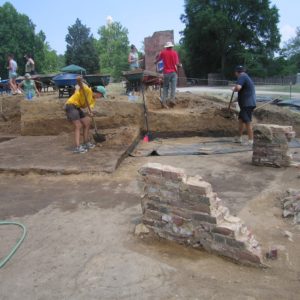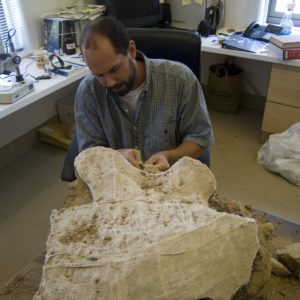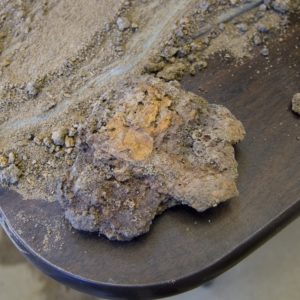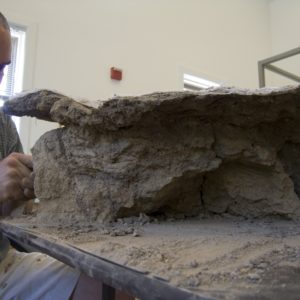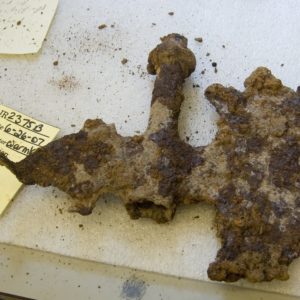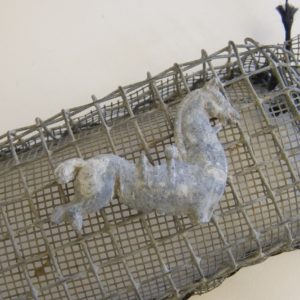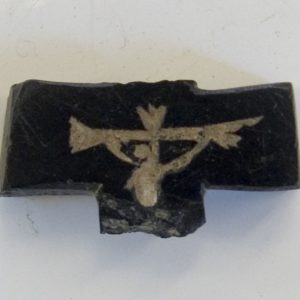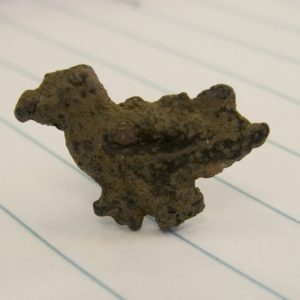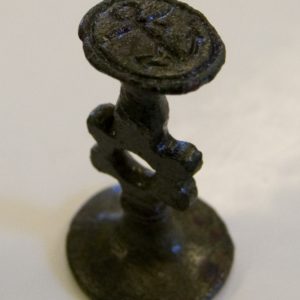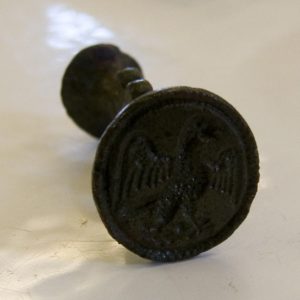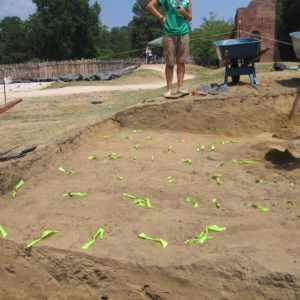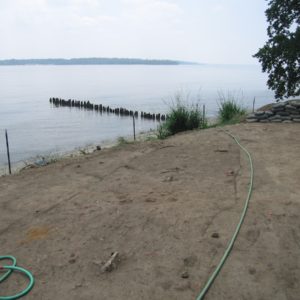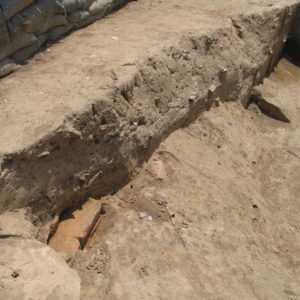The outlines of unmarked grave shafts continue to be discovered in the southwest section of James Fort. Archaeologists are hoping that this means the original church is nearby, but it has yet to be found. The Field School students are helping the full-time archaeologists excavate 10′ x 10′ sections of earth down to the fort-period soil layer. Single burials and a possible double burial have been found along with thousands of artifacts. Meanwhile, near the northern bulwark, the possible well feature is looking more and more like a cellar. Two courses of a brick wall have been found inside the feature. This probable cellar was constructed parallel to the fort palisade wall, indicating it was from the fort period and hence from the earliest years of the colony.
More fort-period graves have been discovered in an area near the southwest corner of the fort. This is the same area where over 20 colonist graves were found in 2005. There is speculation that this unmarked burial ground may indicate that the fort’s original church is nearby, but so far no definitive evidence has been found. A distinct absence of graves in one area which is in-turn surrounded by graves may indicate the presence of a structure, and there have been a few postholes found in this area. The area still needs more precise excavation before all of the features can be known. Danny Schmidt, Jamestown Rediscovery Archaeologist, said that they plan to go back over the area very carefully with trowels to see if further evidence can be found to illustrate the significance of the lack of burials in this one area. A late-17th-century ditch cuts through this area, its age indicated by the presence of pottery known to have been created beginning in the 1680s.
Though the church has not yet been found, thousands of 17th-century artifacts have turned up during the search. A nearly-complete halberd blade was just excavated from the area. It is in remarkable shape and is only mildly oxidized. A small lead horse, probably a children’s toy, was discovered and is similar to one found in October of 2006. A fragment of a crucifix, made of jet, was also found in the area. This is the second jet crucifix found inside James Fort. A brass seal, created for making impressions in wax, was recently excavated. Bly Straube, Curator with Jamestown Rediscovery, explained that the falcon on one side of the seal probably indicates that the owner was a gentleman, as the sport of falconry was a pastime enjoyed by those of higher class. The anchor on the other side hints that the owner was also a seafaring man. An ornamental brass mount in the form of a martlet is another recently-excavated artifact that can tell us something about its owner. A martlet is a mythical bird that has no legs, but instead has tufts of feathers where its legs should be. Martlets were used in English heraldry to represent a later (typically the fourth) son in a family. Whereas the first three sons in a family traditionally had pre-defined paths in life, the fourth had “nowhere to land,” but instead had to create his own fortune.
In an area near the northern bulwark, a subterranean feature discovered several months ago is starting to take a more definite shape. Precise corners of the feature have been found, and two bricks of what was probably once a wall have also been discovered. All of this points to the feature being a cellar, but that conclusion is still not 100% certain. This is the same feature where the cache of sword hilts and other artifacts were found. The structure was built parallel to the fort wall which indicates that the fort walls were standing at the time of construction.
A Borderware pipkin, a type of cooking vessel, is being mended together from pieces found in the cellar and from the early well excavated last year. Conservator Caroline Taylor explained that Border ware pottery originates in the border regions of northeast Hampshire County and western Surrey County in England. It often has a tell-tale yellow/green glaze. Other examples of Border ware in the Historic Jamestowne collection are on display in the Archaearium.
Conservation is also underway on body armor known as a jack of plate that was excavated in 2005. When it was originally found, it was removed along with the earth below and directly around it so that the painstaking process of its conservation could be done indoors over several weeks. Conservator Michael Lavin is now removing the dirt bit by bit so that the armor can be cleaned and stabilized.
The dig will continue over the summer both in the southwest and northern areas of the fort. Weekday visitors to Historic Jamestowne can watch the dig in progress and then see many of their past finds in the Archaearium.
related images
- A probable double burial (left) and single burial
- The brick structure in the foreground is the remains of a 1950s exhibit
- A sherd of Virginia Indian pottery that was found fused to the jack of plate
- Conservator Michael Lavin removes dirt surrounding the jack of plate armor
- Three plates from the jack of plate armor that have rusted together
- Conservator Michael Lavin works on the jack of plate armor
- Halberd blade
- Lead horse, probably a child’s toy
- Border ware pipkin
- Jet crucifix fragment
- Martlet mount
- Brass seal, showing the end with the falcon engraving
- Another view of the falcon seal
- Confederate gun platform
- Late 17th-century ditch
- Possible cellar



